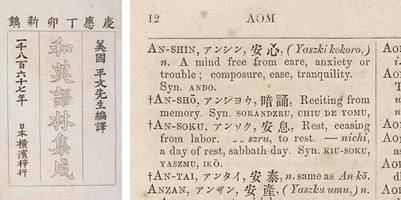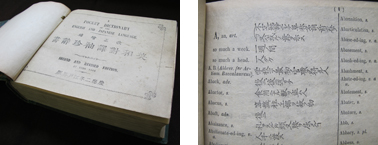The debut of Japanese-English and English-Japanese dictionaries in Japan
(1)The first Japanese-English dictionary in Japan
Very first Japanese-English dictionary in Japan was the Waei Gorin Shūsei (commonly known as "Hepburn's dictionary"), which was published in 1867 (Keiō 3). An English-Japanese index was attached to the Japanese-English content. The dictionary was revised by Hepburn and republished as a second edition in 1872 (Meiji 5), followed by a third in 1886 (Meiji 19). Moreover, a convenient abridged version with no kanji or kana was released in New York and Shanghai, and remained in use until the end of the Meiji era.
 Waei Gorin
Shūsei (1st ed.)
Waei Gorin
Shūsei (1st ed.)
The Hepburn romanization system was used to transliterate the Japanese words for the dictionary. Dr.
Hepburn directly sourced and described most of the words included in the dictionary from all stratum of
Japanese society, making it a valuable Japanese dictionary for its record of words from the Bakumatsu
and Meiji eras, and it remains so for researchers today.
In today's Japan, Dr. Hepburn's name is read as heppubaan. However, the "p" was unvoiced, making the
name sound like hebon to the Japanese in the Bakumatsu and Meiji eras. He was also renowned as a
skillful physician who treated large numbers of his patients for free; a popular folk song in Yokohama
included the words "even Dr. Hepburn and even the hot springs of Kusatsu won't cure this lovesickness"
(hebon-san demo, kusatsu no yu demo, koi no yamai wa naoryasenu).
It is remarkable that, during the Bakumatsu and Meiji years, when the Japanese were most engaged in the
study of the English language—a period of 29 years—no other dictionary came close to equaling Hepburn's
dictionary in popularity.
The only dictionary compiled by a Japanese person that may be regarded as surpassing that of Hepburn is
Sanseidō's 1896 (Meiji 29) Waei Daijiten, edited by Brinkley, Nanjō, and Iwasaki.
(2)The first English-Japanese dictionary in Japan
However, the very first English-Japanese dictionary was the Eiwa Taiyaku Shūchin Jisho, published in 1862 (Bunkyu 2) by the Institution for the Investigation of Western Learning. The dictionary was based on H. Picard's English-Dutch dictionary, A New Pocket Dictionary of the English-Dutch and Dutch-English Languages, with translations of the Dutch sections into Japanese. The word shūchin is the Japanese expression for "pocket edition." It took an entire year to print 200 copies.
 Eiwa
Taiyaku Shūchin Jisho (2nd ed.)
Eiwa
Taiyaku Shūchin Jisho (2nd ed.)
The dictionary continued to be published in the Meiji era, long after the bakufu had disappeared,
appearing as both the Satsuma Jisho and the Kaitaku-shi Jisho, and remained in use until the middle of
the Meiji era, at which point Webster-inspired English-Japanese dictionaries began to appear in Japan.
Angeria Gorin Taisei was discovered during the Meiji era. It had been compiled in 1815(Bunka12)
following the British Warship Phaeton Incident at Nagasaki Harbor and was prized by the Nagasaki bugyō,
but had been written by hand and was more a weapon of national defense than a dictionary that
incorporated and furthered any understanding of culture.
